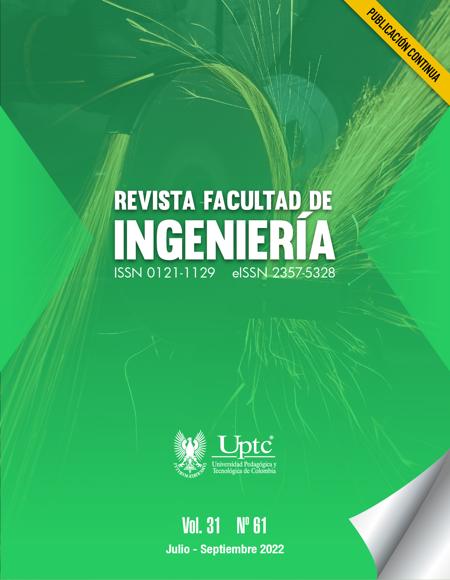Construction of a Video Transmission Scenario in Software-Defined Networks for QoE Estimation

Abstract
The services supported by data networks have become widespread, so the architectures of the new data networks are service-oriented. They are endowed with intelligence, flexibility, and programmability. The preceding is with the aim of providing acceptability by users. Thus, this paper presents the construction of a video transmission scenario over a software-defined network (SDN, Software-Defined Networking) using free software and modifying its behavior with background traffic, on which the Quality of Experience (QoE) is estimated. Subjective and objective metrics were used for the QoE estimation. For the first one, the Mean Opinion Score (MOS) was used, while the second one was studied with the Full Reference Image Quality Assessment (FR-IQA). Finally, a correlation between the two types of metrics was proposed.
Keywords
IQA-FR, MOS, QoE, SDN, Video streaming
Author Biography
Vicko Quizza-Hernández
Roles: Conceptualization, formal analysis, writing-review and editing.
Juan-Camilo Arango-Colorado
Roles: Conceptualization, formal analysis, writing-review and editing.
Wilmar-Yesid Campo-Muñoz
Roles: Supervision, methodology, investigation, writing-review and editing.
References
- J. Nightingale, P. Salva-Garcia, J. M. A. Calero, Q. Wang, “5G-QoE: QoE modeling for ultra-HD video streaming in 5G networks,” IEEE Transactions on Broadcasting, vol. 64, no. 2, pp. 621–634, 2018. https://doi.org/10.1109/TBC.2018.2816786 DOI: https://doi.org/10.1109/TBC.2018.2816786
- O. Sami Oubbati, M. Atiquzzaman, T. Ahamed Ahanger, A. Ibrahim, “Softwarization of UAV networks: A survey of applications and future trends,” IEEE Access, vol. 8, pp. 98073–98125, 2020. https://doi.org/10.1109/ACCESS.2020.2994494 DOI: https://doi.org/10.1109/ACCESS.2020.2994494
- R. Souza, K. Dias, S. Fernandes, “NFV Data Centers: A Systematic Review,” IEEE Access, vol. 8, pp. 51713–51735, 2020. https://doi.org/10.1109/ACCESS.2020.2973568 DOI: https://doi.org/10.1109/ACCESS.2020.2973568
- L. Skorin-Kapov, M. Varela, T. Hoßfeld, K.-T. Chen, “A Survey of Emerging Concepts and Challenges for QoE Management of Multimedia Services,” ACM Transactions on Multimedia Computing, Communications, and Applications, vol. 14, no. 2s, pp. 1–29, Apr. 2018. https://doi.org/10.1145/3176648 DOI: https://doi.org/10.1145/3176648
- ITU, “P.10: Vocabulary for performance, quality of service and quality of experience,” 2017.
- O. B. Maia, H. C. Yehia, L. De Errico, “A concise review of the quality of experience assessment for video streaming,” Computer Communications, vol. 57, pp. 1–12, Feb. 2015. https://doi.org/10.1016/j.comcom.2014.11.005 DOI: https://doi.org/10.1016/j.comcom.2014.11.005
- R. Mijumbi, J. Serrat, J. L. Gorricho, N. Bouten, F. De Turck, R. Boutaba, “Network function virtualization: State-of-the-art and research challenges,” IEEE Communications Surveys & Tutorials, vol. 18, no. 1, pp. 236–262, Jan. 2016. https://doi.org/10.1109/COMST.2015.2477041 DOI: https://doi.org/10.1109/COMST.2015.2477041
- K. Sun, H. Zhang, Y. Gao, D. Wu, “Delay-aware fountain codes for video streaming with optimal sampling strategy,” Journal of Communications and Networks, vol. 21, no. 4, pp. 339–352, Aug. 2019. https://doi.org/10.1109/JCN.2019.000024 DOI: https://doi.org/10.1109/JCN.2019.000024
- L. M. Castaneda Herrera, A. Duque Torres, W. Y. Campo Munoz, “An Approach Based on Knowledge-Defined Networking for Identifying Video Streaming Flows in 5G Networks,” IEEE Latin America Transactions, vol. 19, no. 10, pp. 1737–1744, 2021. https://doi.org/10.1109/TLA.2021.9477274 DOI: https://doi.org/10.1109/TLA.2021.9477274
- A. Hammershoj, A. Nowak, J. K. B. Hansen, C. Stefanovic, “Next-Generation OTT Distribution Architecture Supporting Multicast-Assisted ABR (mABR) and HTTP/3 over QUIC,” in SMPTE 2020 Annual Technical Conference and Exhibition, pp. 31–39, 2022. https://doi.org/10.5594/M001928 DOI: https://doi.org/10.5594/JMI.2021.3114757
- N. C. Robinson, Research Methodology a step-by-step guide for beginners. Ranjit Kumar, 2021.
- M. Erel, E. Teoman, Y. Özçevik, G. Seçinti, B. Canberk, “Scalability analysis and flow admission control in mininet-based SDN environment,” in IEEE Conference on Network Function Virtualization and Software Defined Network, pp. 18–19, 2016. https://doi.org/10.1109/NFV-SDN.2015.7387396 DOI: https://doi.org/10.1109/NFV-SDN.2015.7387396
- Big Buck Bunny Movie, http://www.bigbuckbunny.org
- M. Peuster, H. Karl, S. V. Rossem, “MeDICINE: Rapid Prototyping of Production-Ready Network Services in Multi-PoP Environments,” in IEEE Conference on Network Function Virtualization and Software Defined Networks, pp. 148-153, 2016. https://doi.org/10.1109/NFV-SDN.2016.7919490 DOI: https://doi.org/10.1109/NFV-SDN.2016.7919490
- Garland, Docker Image | Docker Hub, 2022. https://hub.docker.com/r/garland/dockerfile-ubuntu-gnome/.
- S. Avallone, S. Guadagno, D. Emma, A. Pescape, G. Ventre, "D-ITG distributed Internet traffic generator," in First International Conference on the Quantitative Evaluation of Systems, 2004, pp. 316-317. https://doi.org/10.1109/QEST.2004.1348045 DOI: https://doi.org/10.1109/QEST.2004.1348045
- D. van Staden, F. N. Mahomed, S. Govender, L. Lengisi, B. Singh, O. Aboobaker, “Comparing the validity of an online Ishihara colour vision test to the traditional Ishihara handbook in a South African university population,” African Vision and Eye Health, vol. 77, no. 1, e370, Feb. 2018. https://doi.org/10.4102/aveh.v77i1.370 DOI: https://doi.org/10.4102/aveh.v77i1.370
- TU-T, P.910: Subjective video quality assessment methods for multimedia applications, 1999. https://www.itu.int/rec/T-REC-P.910-200804-I/en
- D. Narsaiah, R. S. Reddy, A. Kokkula, P. A. Kumar, A. Karthik, "A Novel Full Reference-Image Quality Assessment (FR-IQA) for Adaptive Visual Perception Improvement," in 6th International Conference on Inventive Computation Technologies, 2021, pp. 726-730, https://doi.org/10.1109/ICICT50816.2021.9358610 DOI: https://doi.org/10.1109/ICICT50816.2021.9358610
- FFMPEG, Ffmpeg.org, 2022. https://ffmpeg.org/documentation.html
- W. Robitza, ffmpeg_quality_metrics., 2022. https://vqeg.github.io/software-tools/quality%20analysis/ffmpeg-quality-metrics/
- Q. Huynh-Thu, M. Ghanbari, “The accuracy of PSNR in predicting video quality for different video scenes and frame rates,” Telecommunication Systems, vol. 49, pp. 35-48, 2012. https://doi.org/10.1007/s11235-010-9351-x DOI: https://doi.org/10.1007/s11235-010-9351-x
- Z. Wang, A. C. Bovik, H. R. Sheikh, E. P. Simoncelli, "Image quality assessment: from error visibility to structural similarity". IEEE Transactions on Image Processing, vol. 13, no. 4, pp. 600–612, Apr. 2004. https://doi.org/10.1109/TIP.2003.819861 DOI: https://doi.org/10.1109/TIP.2003.819861
- F. Zhang, A. Katsenou, C. Bampis, L. Krasula, Z. Li, D. Bull, "Enhancing VMAF through New Feature Integration and Model Combination," in Picture Coding Symposium (PCS), 2021, pp. 1-5, https://doi.org/10.1109/PCS50896.2021.9477458 DOI: https://doi.org/10.1109/PCS50896.2021.9477458
- A. Leixi, Full Reference Video Quality Evaluation Method (PSNR, SSIM) and Conversion Model with MOS, 2013. https://blog.csdn.net/leixiaohua1020/article/details/11694369